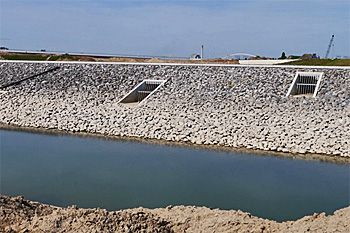First Overtopping Threshold of Flood Relief Channel along River Rhine
Published on by Water Network Research, Official research team of The Water Network in Technology
The river Rhine has overtopped the threshold of the 3,5 km long flood relief channel Spiegelwaal, near Nijmegen, the Netherlands for the first time on 12 February
High river discharges made the water level to rise above the height of the special constructed threshold. For three days the river flowed through the relief channel along the river Rhine (Waal).
The flood relief channel was specially constructed as part of the national Room for the river programme to be prepared for the passage of an extreme discharge up to 16.000 m3/s without causing river floods.
The highest discharge ever recorded on the river Rhine was 12.400 m3/s in 1926.
The flood relief channel was officially commissioned by Dutch minister Melanie Schultz van Haegen of Infrastructure and environment only two months earlier.
Iconic river project
The construction of the flood relief channel at Nijmegen is seen as the most iconic of all 30 projects of the Room for the river programme that have been realised along the river Rhine between 2005 and 2015.
To be able to allow a larger discharge to pass the bottleneck at Nijmegen, it was decided not heighten the river levees, but to move them 350 m inland. This created room for a 3,5 km long flood relief channel.
Most iconic about the project is how the channel has been designed to fit into the landscape. On the island between the main river and the channel, a dynamic river park and a water front has been created for citizens to recreate.
Three new bridges connect the island to the city.
Asymmetrical threshold
The threshold at the beginning of the side channel is the main hydrologic precondition for the functioning of the flood relief.
It has been constructed asymmetrical with coarse on the upstream side and a smooth finish on the side of the channel.
At high water the threshold can overtop without causing erosion. It has been designed to overtop with an average of 11 days per year.
Six inlets at various levels, allow the continuous intake of fresh river water in to the flood relief channel when it does not flow. The fresh river water assures good water quality in stagnant areas.
Source: Dutch Water Sector
Read More Related Content On This Topic - Click Here
Media
Taxonomy
- Infrastructure
- Construction
- Flood